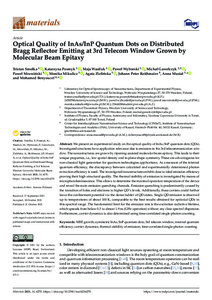| dc.date.accessioned | 2022-01-05T14:17:43Z | |
| dc.date.available | 2022-01-05T14:17:43Z | |
| dc.date.issued | 2021-10-21 | |
| dc.identifier | doi:10.17170/kobra-202112235347 | |
| dc.identifier.uri | http://hdl.handle.net/123456789/13488 | |
| dc.description.sponsorship | Gefördert durch den Publikationsfonds der Universität Kassel | ger |
| dc.language.iso | eng | eng |
| dc.rights | Namensnennung 4.0 International | * |
| dc.rights.uri | http://creativecommons.org/licenses/by/4.0/ | * |
| dc.subject | MBE growth | eng |
| dc.subject | symmetric InAs/InP quantum dots | eng |
| dc.subject | 3rd telecom window | eng |
| dc.subject | internal quantum efficiency | eng |
| dc.subject | carrier dynamics | eng |
| dc.subject | thermal stability of emission | eng |
| dc.subject | time-correlated single-photon counting | eng |
| dc.subject.ddc | 600 | |
| dc.title | Optical Quality of InAs/InP Quantum Dots on Distributed Bragg Reflector Emitting at 3rd Telecom Window Grown by Molecular Beam Epitaxy | eng |
| dc.type | Aufsatz | |
| dcterms.abstract | We present an experimental study on the optical quality of InAs/InP quantum dots (QDs). Investigated structures have application relevance due to emission in the 3rd telecommunication window. The nanostructures are grown by ripening-assisted molecular beam epitaxy. This leads to their unique properties, i.e., low spatial density and in-plane shape symmetry. These are advantageous for non-classical light generation for quantum technologies applications. As a measure of the internal quantum efficiency, the discrepancy between calculated and experimentally determined photon extraction efficiency is used. The investigated nanostructures exhibit close to ideal emission efficiency proving their high structural quality. The thermal stability of emission is investigated by means of microphotoluminescence. This allows to determine the maximal operation temperature of the device and reveal the main emission quenching channels. Emission quenching is predominantly caused by the transition of holes and electrons to higher QD’s levels. Additionally, these carriers could further leave the confinement potential via the dense ladder of QD states. Single QD emission is observed up to temperatures of about 100 K, comparable to the best results obtained for epitaxial QDs in this spectral range. The fundamental limit for the emission rate is the excitation radiative lifetime, which spreads from below 0.5 to almost 1.9 ns (GHz operation) without any clear spectral dispersion. Furthermore, carrier dynamics is also determined using time-correlated single-photon counting. | eng |
| dcterms.accessRights | open access | |
| dcterms.creator | Smołka, Tristan | |
| dcterms.creator | Posmyk, Katarzyna | |
| dcterms.creator | Wasiluk, Maja | |
| dcterms.creator | Wyborski, Paweł | |
| dcterms.creator | Gawełczyk, Michał | |
| dcterms.creator | Mrowiński, Paweł | |
| dcterms.creator | Mikulicz, Monika | |
| dcterms.creator | Zielińska, Agata | |
| dcterms.creator | Reithmaier, Johann Peter | |
| dcterms.creator | Musiał, Anna | |
| dcterms.creator | Benyoucef, Mohamed | |
| dc.relation.doi | doi:10.3390/ma14216270 | |
| dc.subject.swd | Quantenpunkt | ger |
| dc.subject.swd | Molekularstrahlepitaxie | ger |
| dc.subject.swd | Telekommunikation | ger |
| dc.subject.swd | Quantenausbeute | ger |
| dc.subject.swd | Carrier | ger |
| dc.subject.swd | Temperaturbeständigkeit | ger |
| dc.type.version | publishedVersion | |
| dcterms.source.identifier | eissn:1996-1944 | |
| dcterms.source.issue | Issue 21 | |
| dcterms.source.journal | Materials | eng |
| dcterms.source.volume | Volume 14 | |
| kup.iskup | false | |
| dcterms.source.articlenumber | 6270 | |


